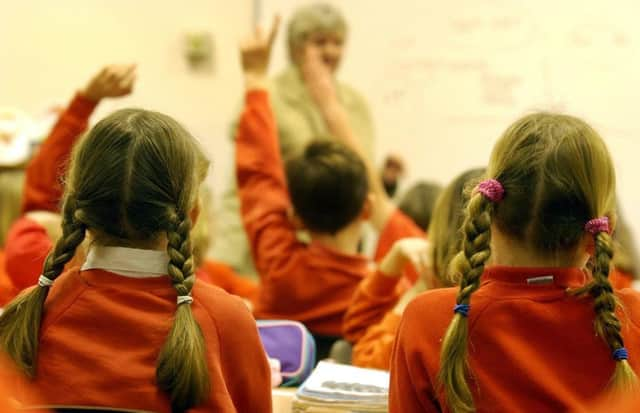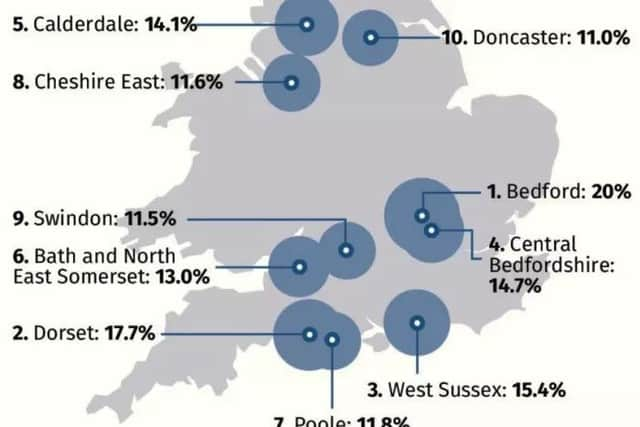Halifax and Doncaster primaries in UK's bottom 10: See how YOUR school rates


Calderdale and Doncaster are among the 10 authorities with the highest percentage of primary schools failing to make the grade.
In Calderdale, 14.1 per cent of primary schools are under-performing, making it the fifth worst in the country, while in Doncaster the figure is 11 percent, ranking it 10th.
Advertisement
Hide AdAdvertisement
Hide AdNationally, almost 200,000 children at primary schools are considered to be under performing, and in total, 665 mainstream primaries in England fell below the Government's floor standard this year, according to the Department for Education.


LEAGUE TABLES IN FULL
The government has published performance tables for every primary school. View the tables as they appear in The Yorkshire Post. Or click the links to view tables for each local authority, from the Department for Education


The statistics also show wide regional variations. In Yorkshire and the Humber, there are 81 primary schools (5.4 per cent) which are considered to be under performing. The regions with the highest percentage are the East Midlands (6.9 per cent) and the South West (6.8 per cent), with children in London the most likely to get a decent primary school education, with just 0.9 per cent of schools deemed to be under performing.
Across Yorkshire, the figures vary for the number of pupils who are reaching the expected standard in reading, writing and maths.
Advertisement
Hide AdAdvertisement
Hide AdThe best figure is Rotherham with 54 per cent, followed by Hull, the East Riding and Barnsley, all on 53 per cent.
The lowest is Doncaster, with 46 per cent, while Bradford and Calderdale both have 47 per cent. Leeds has 48 percent of pupils reaching the expected standard, with 52 per cent in both York and Sheffield.
Calderdale Council did not provide a comment.
Doncaster Council says it acknowledges 'the need to continue to improve educational attainment and skills' and says it has put a series of measures in place to help achieve this.
It says reading is a specific area of focus and it has developed a raising achievement initiative which is seeing a concentrated effort on reading this academic year to drive through improvement for all pupils across the borough.
Advertisement
Hide AdAdvertisement
Hide AdAnd it says it is dealing with a 'legacy of underachievement in Doncaster', which is why an independent report by an Education Skills Commission has been commissioned.
The latest data comes after a tumultuous year for primary assessment, including major changes to toughen up the tests and concerns raised by teachers and school leaders about pressure on pupils and unreliability of results.
School Standards Minister Nick Gibb said this year's SATs tests - or national curriculum tests - are the first to test pupils on a new primary curriculum introduced in 2014, which was brought in to "raise expectations" and ensure youngsters get a good grounding in the basics."
Schools are considered under-performing if fewer than 65 per cent of pupils reach the expected standard in reading, writing and maths, or if they fail to make sufficient progress in these three key areas.
Advertisement
Hide AdAdvertisement
Hide AdOverall, five per cent of primaries fell below the government threshold this year.
Education Secretary Justine Greening had previously pledged than no more than six per cent would be below the benchmark. She also promised that no school would face outside intervention based on this year's data alone.
According to analysis of the data, around 180,743 children are being taught at the 665 primaries that failed to meet the Government's new threshold. This is around 4.1 per cent of the total number of youngsters at mainstream primary schools in England.
Across England, 53 per cent of the almost 600,000 11-year-olds who took the tests reached the expected standard in reading, writing and maths this year.
Advertisement
Hide AdAdvertisement
Hide AdThe data shows that poor children are falling behind their richer classmates - 35 per cent of children eligible for free school meals reached the expected standard in all three areas this year, compared with 57% of those who do not receive free dinners.
Mr Gibb said: "This year's SATs are the first that test the new primary school curriculum in English and maths that we introduced in 2014. This new curriculum raises expectations."